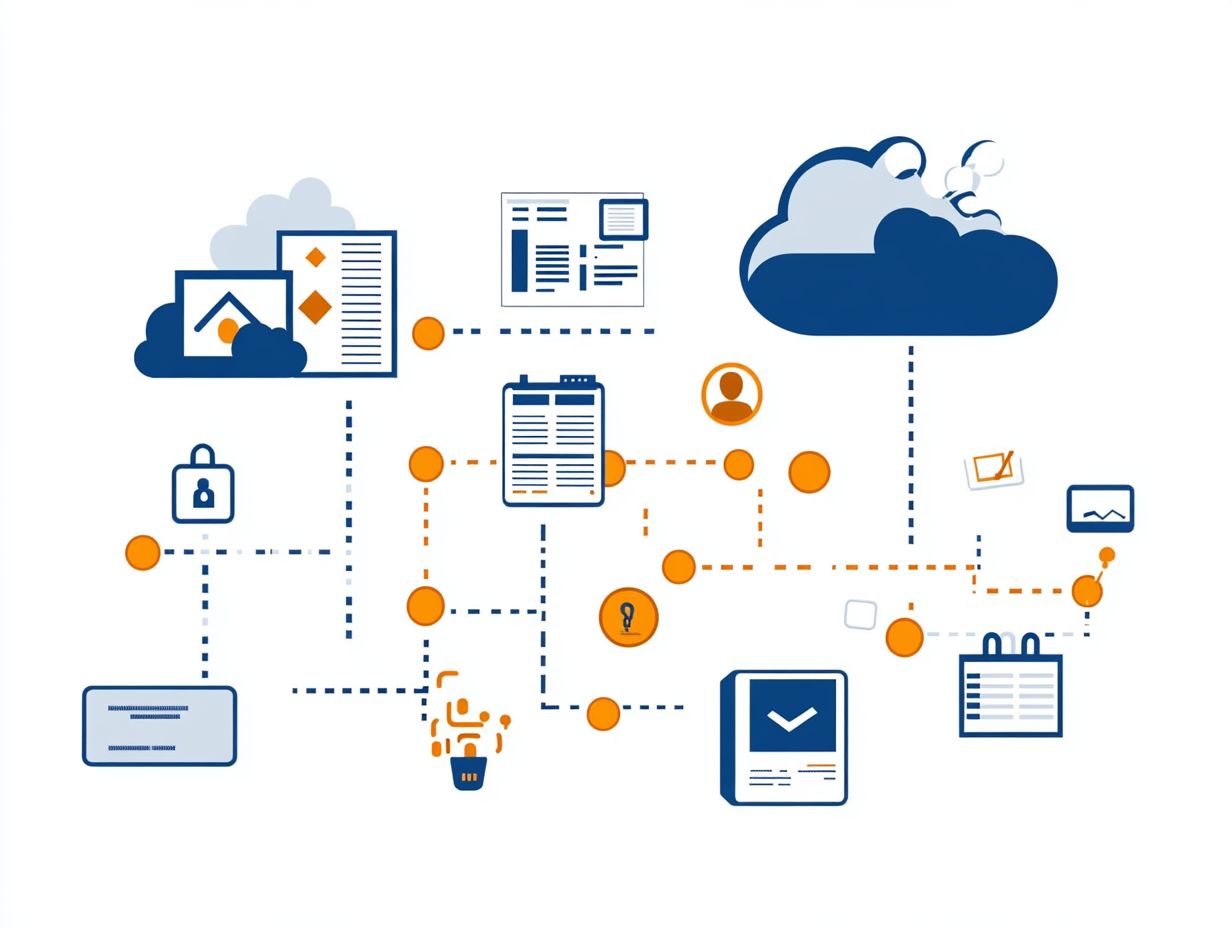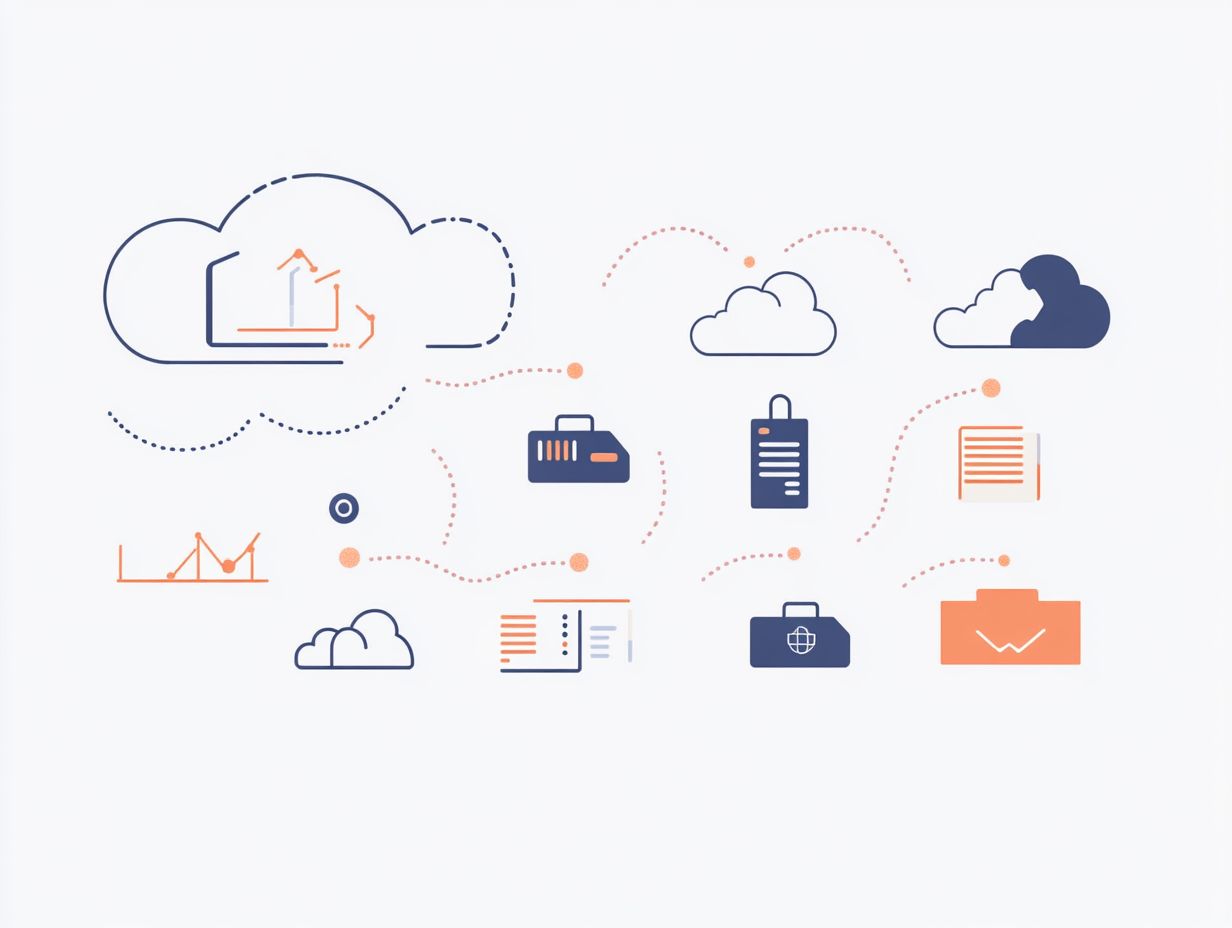Understanding the Timeline for Cloud Migration
Contents
- Cloud Migration: Enhance Your Business Efficiency
- Key Takeaways:
- What is Cloud Migration?
- Benefits of Cloud Migration
- Factors to Consider Before Migrating to the Cloud
- Assessing Your Current Infrastructure
- Cost Analysis
- The Timeline for Cloud Migration
- Common Challenges and Solutions
- Frequently Asked Questions
- What is cloud migration and why is it important?
- What factors should be considered when creating a timeline for cloud migration?
- How long does the timeline for cloud migration typically take?
- What are the stages of cloud migration?
- What challenges can arise during cloud migration?
- How can a business ensure a smooth cloud migration?
Cloud Migration: Enhance Your Business Efficiency
Cloud migration is rapidly becoming an essential strategy for businesses like yours that seek to enhance efficiency and scalability.
This article delves into the many benefits of transitioning to the cloud, showcasing the compelling advantages for organizations eager to optimize their operations. It also examines important factors you should consider before making the leap, such as your current infrastructure and a thorough cost analysis.
It also outlines the timeline for the migration process and addresses common challenges, offering practical solutions to ensure a seamless transition.
Explore how cloud migration can redefine your business landscape!
Key Takeaways:

Cloud migration offers numerous benefits for businesses, including cost savings and increased flexibility. Before migrating to the cloud, it is important to assess your current infrastructure and conduct a cost analysis. The timeline for cloud migration typically includes three phases: pre-migration, migration, and post-migration.
What is Cloud Migration?
Cloud migration involves transferring your digital assets and IT infrastructure from on-premises servers to cloud-based environments like Amazon Web Services, Google Cloud Platform, or Azure. This process is vital for your business, aiming to harness the scalability, flexibility, and cost-efficiency that cloud computing offers.
By doing so, you can enhance customer experiences and boost operational efficiency. Whether you’re migrating specific applications or entire project infrastructures, understanding the intricacies of cloud integration is essential for a successful transition.
Effective cloud migration is essential in today s digital world. By embracing cloud computing, you unlock a range of models from public and private clouds to hybrid solutions that are tailored to your specific operational needs.
Engaging skilled migration teams is pivotal in this journey; their expertise in strategies such as moving, changing, or redesigning applications ensures a smoother transition. The impact on your business operations can be transformative, enhancing agility, reducing downtime, and improving disaster recovery options, all of which drive sustained growth in an increasingly competitive landscape.
Benefits of Cloud Migration
Cloud migration presents a multitude of advantages for businesses like yours, from substantial cost optimization to heightened operational efficiency and a more profound business impact.
By embracing applications designed to run in the cloud, you can leverage scalable resources and lower IT infrastructure expenses, ultimately unlocking financial benefits while also promoting sustainability through a reduced environmental footprint.
Advantages for Businesses
One of the primary advantages of migrating to the cloud is the opportunity to leverage applications designed to run in the cloud, which can significantly streamline your operations and enhance overall efficiency.
This translates into improved customer experiences, as you gain access to fast data and can optimize resources more effectively, ultimately leading to greater satisfaction and loyalty among your clients.
The shift to the cloud fosters enhanced collaboration among your teams, no matter where they are located, enabling seamless communication and resource sharing.
As your business scales, you have the flexibility to adjust your infrastructure to meet fluctuating demands, ensuring you remain agile in rapidly changing markets.
Access to advanced cloud management services allows you to automate various processes, boosting operational efficiency and reducing overhead costs.
This transformative approach not only facilitates better decision-making but also gives you the power to innovate and tailor your offerings, resulting in an exceptional experience for your customers.
Factors to Consider Before Migrating to the Cloud
Before you embark on your cloud migration journey, it’s essential to evaluate several factors that can significantly impact the success of your migration strategy.
A thorough assessment of your current IT infrastructure, coupled with a detailed cost analysis, is vital. By understanding these elements, you can align your cloud management efforts with your business goals, paving the way for a smoother and more effective transition to the cloud.
Don t miss out on the benefits of cloud migration! Assess your options today.
Assessing Your Current Infrastructure

Assessing your current infrastructure is an essential step in the cloud migration journey. This evaluation allows you to pinpoint legacy systems that may require updates or replacements with cloud systems.
By conducting this thorough assessment, you ensure data validation and confirm that all existing systems are compatible with your chosen cloud solutions. This paves the way for a more successful migration.
During this comprehensive evaluation, you can employ various techniques, such as inventory audits and performance testing, to uncover inefficiencies or bottlenecks within your existing framework. It’s crucial to identify potential challenges, like data silos or compliance issues, to ensure that the migration aligns seamlessly with your organizational goals.
Using automated dependency mapping tools provides valuable insights into interdependent systems and their data flows. This approach not only aids in a smooth transition to the cloud but also enhances scalability and resilience for the long term.
Cost Analysis
Conducting a comprehensive cost analysis is vital for clarifying your migration goals and ensuring you don’t miss potential financial benefits. It helps you maximize the effective use of cloud resources.
This analysis empowers you to make informed decisions about which cloud services partner to choose and how to allocate resources during the migration process.
This detailed assessment includes both direct costs, like subscription fees and implementation expenses, as well as indirect costs, such as training and downtime. By identifying these elements, you can uncover potential avenues for savings while evaluating your expectations for returns on investment (ROI).
Ultimately, the insights gained from a well-structured cost analysis allow you to strategically plan your cloud adoption. This ensures your initiatives align with long-term goals and enables you to fully leverage the benefits of scalable cloud solutions.
The Timeline for Cloud Migration
Grasping the timeline for cloud migration is crucial for your business, as it involves several key phases: pre-migration, migration, and post-migration. Each of these stages carries distinct tasks and objectives that require meticulous planning. By doing so, you can ensure a seamless transition, minimize risks, and effectively meet your migration goals.
Pre-Migration Phase
The pre-migration phase is essential for establishing a solid foundation for your cloud migration. It s crucial to plan this transition meticulously with a seasoned migration team.
During this phase, you ll develop cloud strategies that align seamlessly with your business goals, ensuring that all necessary preparations are in place for a successful move. One of your first tasks will be selecting the right cloud provider tailored to your specific needs, as this choice can significantly influence both performance and cost.
Assessing data safety is paramount; evaluating security protocols and compliance measures will help safeguard sensitive information during and after the migration.
Preparing your project infrastructure means mapping out current resources, understanding dependencies, and creating a timeline for key milestones. By zeroing in on these critical elements, you can pave the way for a smooth migration, ultimately maximizing operational efficiency and enhancing your overall agility in the cloud environment.
Migration Phase
The migration phase is where you actually transfer data from your legacy systems to cloud environments. This may involve server migration and workload containerization to ensure resources are allocated optimally. During this critical stage, careful execution is paramount to ensure data safety and minimize downtime.
To ensure a smooth transition, it’s essential to use secure connections, like VPNs or dedicated lines, to protect sensitive information from potential breaches during transit. You should also implement robust data integrity validation methods, such as checksum verifications and error-checking algorithms, to guarantee that all data arrives uncorrupted and intact.
Utilizing automated tools for monitoring and reporting can further elevate the process. These tools provide real-time insights into the data transfer, enabling swift troubleshooting and ensuring compliance with regulations.
Post-Migration Phase

The post-migration phase is vital for ensuring that your newly migrated environments run smoothly. Focus on managing your cloud services and conducting a thorough performance review to meet your migration goals.
This phase gives you the opportunity to evaluate the success of the migration and make necessary adjustments for continuous optimization.
Monitoring your cloud resources is essential. This allows your team to track performance metrics and pinpoint any bottlenecks that may arise. Compliance is crucial. Your new setups must meet relevant regulations and security standards.
Gathering user feedback is key to understanding how well the migration meets the needs of your stakeholders. This sets the stage for further enhancements. By prioritizing these tasks, you can refine your strategies, ensuring that your cloud environments operate seamlessly and propel your overall business objectives forward.
Common Challenges and Solutions
Cloud migration presents a range of challenges, including navigating technical hurdles and addressing employee resistance. Both can obstruct a seamless transition to cloud environments.
Identifying these challenges early positions you to implement effective solutions and mitigate potential risks throughout the migration process.
Overcoming Technical Hurdles
Overcoming technical hurdles is a crucial concern during cloud migration, as these challenges can significantly impact your data safety and the overall success of the process.
By harnessing automation and utilizing advanced cloud management services, you can streamline operations and minimize the chances of encountering technical issues.
You may face specific challenges, such as data compatibility issues between legacy systems and new cloud environments. These complications can lead to data loss or integrity concerns, detrimental to your business.
Integration challenges are also common, particularly when aligning various applications and services with existing infrastructure.
To mitigate these risks, adopt a phased migration approach. This means moving your data in stages rather than all at once, and conducting thorough pre-migration assessments while leveraging automation tools for effective data mapping.
Implementing robust backup solutions is essential for ensuring data safety throughout the migration process. This allows you to recover swiftly if any issues arise.
Managing Employee Resistance
Managing employee resistance is essential for a successful cloud migration. Staff may feel uneasy about changes to their established workflows and IT infrastructure.
Implementing effective communication strategies and actively engaging your team in the migration process can help alleviate their concerns and enhance the overall experience.
Fostering open dialogue creates an environment where employees feel valued and heard, significantly reducing anxiety associated with such transitions.
Training sessions focused on new tools and processes equip your team with necessary skills and instill confidence in the security measures being implemented.
This dual approach encourages collaboration, allowing teams to see the migration as an opportunity for growth rather than just a disruptive change. Ultimately, when your employees understand the benefits and feel empowered through training, they are much more likely to embrace the transition with enthusiasm.
Frequently Asked Questions
What is cloud migration and why is it important?

Cloud migration is the process of transferring data, applications, and other business elements from a local server to a cloud-based platform. It is important because it allows for increased scalability, accessibility, and cost-efficiency for businesses.
What factors should be considered when creating a timeline for cloud migration?
Factors to consider when creating a timeline for cloud migration include the size and complexity of your data and applications, the readiness and availability of your team, any potential downtime for your business, and the capabilities of your chosen cloud provider.
How long does the timeline for cloud migration typically take?
The timeline for cloud migration can vary based on a business’s specific needs. On average, it takes 6 to 12 months, but larger systems might need more time.
What are the stages of cloud migration?
Cloud migration typically involves several stages: planning and assessment, testing, data migration, application migration, and management after the move. Understanding each step is crucial for success.
What challenges can arise during cloud migration?
Common challenges include data security issues, technical compatibility problems, unexpected delays, and managing the new cloud environment. Being aware of these can help businesses prepare better.
How can a business ensure a smooth cloud migration?
To achieve a smooth migration, businesses should plan thoroughly and assess their needs. Clear communication with all parties and having backup plans for potential issues are also essential.






